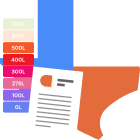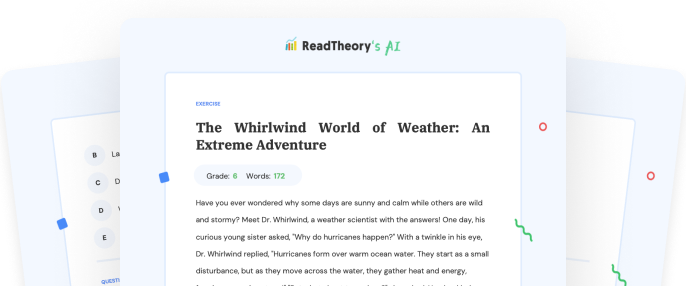Transform Your Teaching
with AI-Powered Worksheets
With ReadTheory’s Instant Worksheet Builder, you can create engaging, grade-appropriate worksheets tailored to your students in minutes. Spark curiosity, save time, and empower critical thinking with AI-powered tools designed for teachers like you.


Unveiling The Earth: A Geological, Astronomical, and Atmospheric Perspective
The Earth, our home, is a unique and complex planet teeming with life, a product of its geological, astronomical, and atmospheric characteristics. Beneath our feet, the Earth is composed of various layers, the crust, mantle, outer core, and inner core, each playing a pivotal role in the planet s behavior. The crust s fragmented pieces, known as tectonic plates, move and interact, leading to natural phenomena like earthquakes and volcanic eruptions. In the cosmic theatre, Earth holds a privileged position, the third planet from the sun in our solar system. Its elliptical orbit and axial tilt result in the changing seasons we experience. The Earth s rotation on its axis gives us the cycle of day and night, a fundamental rhythm of life on earth. The Earth s atmosphere, a thin layer of gases enveloping our planet, works as an invisible shield protecting us from solar radiation. It s also instrumental in climate and weather patterns, playing host to the water cycle, cloud formation, and various weather phenomena. When we understand these aspects of our home planet, we not only deepen our appreciation for its complexity but also recognize the delicate balance that allows life to thrive. Therefore, studying our planet is not just about understanding rocks, orbits, and weather patterns, but about appreciating the interconnectedness of these elements and their role in fostering life.
Question 1
What is the Earth s outermost layer called?
Mantle
Inner Core
Outer Core
Crust
Question 2
What causes the changing of seasons on Earth?
Earth s rotation on its axis
Earth s elliptical orbit and axial tilt
Movement of tectonic plates
Solar radiation
Volcanic eruptions
Question 3
What natural phenomena are a result of the movement and interaction of tectonic plates?
Rainfall
Seasonal changes
Solar radiation
Earthquakes and volcanic eruptions
Night and day cycle
Question 4
What is Earth s position in our solar system?
First planet from the sun
Second planet from the sun
Third planet from the sun
Fourth planet from the sun
Fifth planet from the sun
Question 5
What does the Earth s atmosphere protect us from?
Volcanic eruptions
Earthquakes
Solar radiation
Rainfall
Wind
 or share via
or share via

Assign the ReadTheory pretest to determine students' reading levels.

Why Teachers Love
Instant Worksheet Builder?

Tailored Content for Every Student
Craft worksheets with passages and multiple-choice questions customized to your chosen topic and grade level, ensuring relevance and engagement.

Save Hours
of Prep Time
Our AI, Lexi, generates complete worksheets—passages, questions, and answers—in minutes, freeing you to focus on teaching, not planning.

Standards-Aligned Learning
Every worksheet is designed to boost reading comprehension and critical thinking, aligning seamlessly with State Standards to help your students shine.
Personalized teaching
for personalized learning
Browse worksheets created and refined by educators using Lexi—your source for inspiration and ready-to-use resources.


ReadTheory is free for Teachers to use.
Join thousands of educators using ReadTheory for free. Sign up today and start creating in just minutes!





